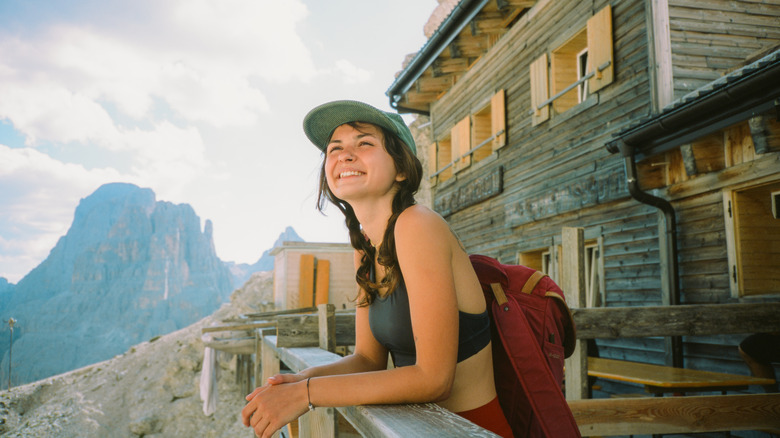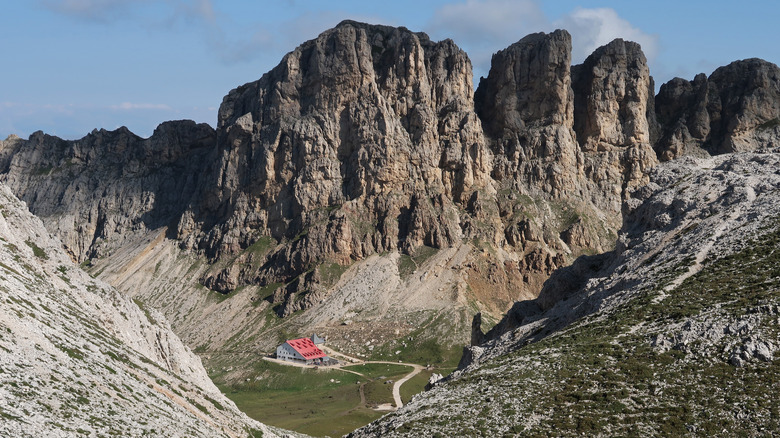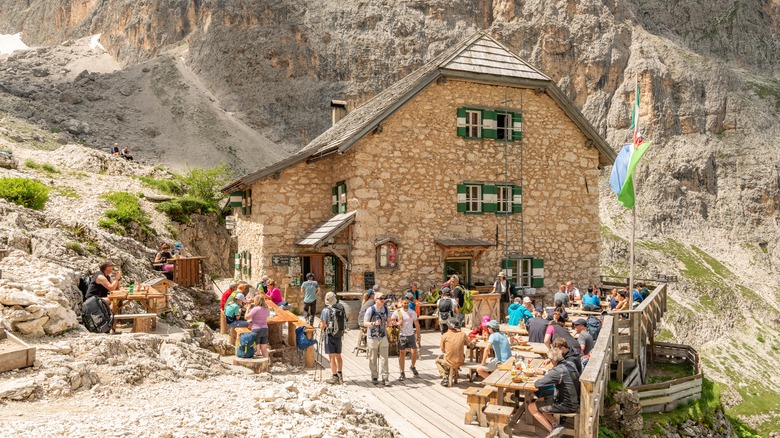The Unconventional Place To Stay In Italy That Offers Far More Majestic Views Than Any Hotel
The Dolomites mountain range in northern Italy is undoubtedly one of the best destinations for your next mountain vacation in Europe. Easy to get to from Milan, Venice, or major cities in other countries, they are an alpine wonderland of lush meadows, sparkling lakes, and towering peaks that draws over 30 million visitors each year. With that many people seeking scenery and fresh air, it is no surprise that a wide array of accommodation has sprung up to cater for them, from glamorous ski resorts to stunning modernist eco-hotels. But for the best views (and less pressure on your bank balance) there is a more unconventional option: Mountain huts.
Like other Alpine regions in Europe, Italy's "rifugi" sprang up towards the end of the 19th century as people became increasingly interested in hiking and mountaineering. As the name suggests, they began as rudimentary shacks to provide refuge or basic shelter from the elements. Nowadays there are around 130 main refuges and many more smaller huts dotted all across the Italian national park, providing a cheap and scenic option for outdoor lovers who don't mind trading a little comfort and privacy for the chance to connect more directly with the natural splendor of the mountains and valleys. This is becoming an increasingly attractive alternative option for exploring the region and enjoying the best views in the Dolomites. While in some cases you can still rock up at a hut unannounced and find a berth for the night, it is best to make reservations months in advance at the more popular locations.
What to expect from a mountain hut stay
Most well-established mountain huts offer a range of accommodation from communal-style dorms with beds for anywhere between six and 20 people to private rooms for smaller parties. Sleeping arrangements can be pretty cozy in larger dorm rooms, with bunks lined up side-by-side with only just enough floor space to squeeze through. Bedding is provided, but not changed after every guest. With this in mind, it is important to bring your own sleeping bag for hygienic purposes.
Facilities are mostly basic with a boot room for muddy hiking shoes, shared bathrooms with coin-operated showers, and a communal dining area. You can choose from room only or half-board with breakfast and dinner included in the price. Food options vary from hut to hut, so it is worth doing some homework before choosing which option suits you better. In some huts, breakfast may just boil down to bread with jam or spread and a hot drink. Lunch and dinner tends to be a little more exciting with a range of pastas, grilled sandwiches, and even wood-fired pizza on the menu. If you are planning a longer hike stopping off at several huts along the way, it's a good idea to bring a selection of snacks to keep you going if the food offerings don't completely satisfy your needs. Also bring your smartphone but don't expect anything more than basic connectivity — while many huts have wifi, signal strength in the Dolomites can be patchy.
A cheap room with a view
So the "rifugi" of the Italian Dolomites are a cheap option where you will get to socialize with other hikers, but what about the views? This has to be the best thing about mountain huts — by their nature, most are situated high up in the mountains and offer spectacular panoramas that many five-star resorts can only dream of. For 360-degree panoramas, seek out a stay at Rifugio Capanna Fassa, located at the summit of Piz Boè (10,400 feet), regarded as one of the easiest mountains of its size in the Dolomites. It's a small place with just 22 beds, but doesn't skimp on comfort, providing hearty home cooking and a cozy fireplace. Another hut with jaw-dropping surroundings is Rifugio Nuvolau, perched miraculously on a rocky stack at an altitude of almost 8,500 feet. With small dorms sleeping between three and eight people, it has been welcoming visitors since 1883.
Although mountains are the USP of the rifugi, they're not all stuck on top of a craggy peak. The charming Rifugio Palmieri is situated next to a tranquil alpine lake surrounded by pine trees with a hobbit-like sauna where you can unwind and take in the view. The very photogenic Talschlusshütte in Fiscalina Valley has brighter lodgings and prides itself on the gourmet menu created from locally sourced ingredients. Whichever hut you stop at, one thing is a constant: Those amazing views. Here's why April is the best time to visit the Dolomites.


